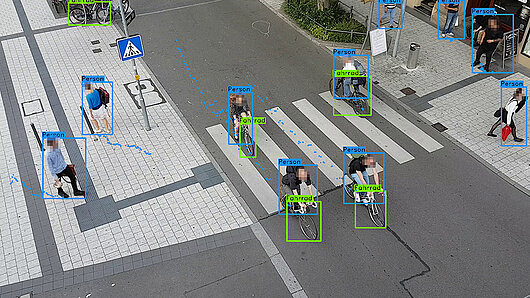High-Performance Computing Center Stuttgart

According to HLRS Visualization Department leader Dr.-Ing. Uwe Wössner, "Past HLRS projects have shown that simulation can offer powerful tools for studying complex urban environments. In Cape Reviso, we are very excited for the chance to explore how it could support the more widespread adoption of sustainable transportation." The simulation methods developed in the new project should be applicable not only for improving life for cyclists and pedestrians, but also in designing other kinds of temporary changes in city traffic, such as during road construction projects.
Although motorized vehicles, bicycles, and pedestrians use streets, parks, and other kinds of public locations very differently, they must often share the same spaces. In certain bottleneck locations, this can lead to stress, conflicts, and even injuries. As cities increasingly promote foot and bicycle traffic over automobiles, ensuring that city residents use them more frequently means making them safer and more enjoyable.
Cape Reviso aims to provide city planners with new tools for doing so. After installing a custom camera system at a chosen location, the project will conduct a long-term observation of pedestrian, bicycle, and motorized vehicle movements. The data that are gathered will then be analyzed using machine learning to develop a model of how the space is used.
Simultaneously, researchers from the Karlsruhe Institute of Technology's Urban Emotions program will register Stuttgart residents to use a monitoring device involving a mobile app connected to wearable stress sensors. The system anonymously measures stress levels and spatial relationships among people, cyclists, and other vehicles, while enabling users to provide feedback on their feelings and observations about traffic the city.
The ADFC (Allgemeiner Deutscher Fahrrad-Club) will support the project by encouraging the public to use an additional app in which users annotate pictures showing many different types of transportation. The crowdsourced responses will serve as input for data training sets for the machine learning algorithms used in the study.
Once the data are gathered, the Cape Reviso researchers will develop a digital twin — a comprehensive virtual reality (VR) simulation — of the location. The digital twin will be presented in a CAVE immersive, 3-dimensional VR environment, where Stuttgart city planners will be able to observe how cyclists and pedestrians move and interact, and then virtually test how different kinds of interventions — such as changes in signage or use of color on surfaces — might affect traffic. Based on these experiments, planners could then test these scenarios in the "Living Lab" at the physical location, comparing real-world behaviors with the simulation.
Cape Reviso builds on techniques developed during the Reallabor Stadt:Quartiere 4.0 Project, in which HLRS created a digital twin of the city of Herrenberg to encourage public participation in urban planning.
—Christopher Williams
